Related Research Articles

Pope Agapetus II was the bishop of Rome and ruler of the Papal States from 10 May 946 to his death. A nominee of the princeps of Rome, Alberic II of Spoleto, his pontificate occurred during the period known as the Saeculum obscurum.

Boniface, OSB was an English Benedictine monk and leading figure in the Anglo-Saxon mission to the Germanic parts of Francia during the eighth century. He organised significant foundations of the church in Germany and was made bishop of Mainz by Pope Gregory III. He was martyred in Frisia in 754, along with 52 others, and his remains were returned to Fulda, where they rest in a sarcophagus which remains a site of Christian pilgrimage.

The Electorate of Mainz, previously known in English as Mentz and by its French name Mayence, was one of the most prestigious and influential states of the Holy Roman Empire. In the Roman Catholic hierarchy, the Archbishop-Elector of Mainz was also the Primate of Germany, a purely honorary dignity that was unsuccessfully claimed from time to time by other archbishops. There were only two other ecclesiastical Prince-electors in the Empire: the Electorate of Cologne and the Electorate of Trier.

Karl Lehmann was a German Cardinal prelate of the Catholic Church. He served as Bishop of Mainz from 1983 to 2016, being elevated to Cardinal in 2001. He also served as Chairman of the Conference of the German Bishops from 1987 to 2008, being considered one of the most influential prelates in Germany in these years and a leading proponent of liberal stances within the Church. Before he became a bishop, he worked as professor of theology at the University of Mainz and the University of Freiburg.

The Diocese of Mainz, historically known in English as Mentz as well as by its French name Mayence, is a Latin Church ecclesiastical territory or diocese of the Catholic Church in Germany. It was founded in 304, promoted in 780 to Metropolitan Archbishopric of Mainz and demoted back in 1802 to bishopric. The diocese is suffragan diocese in the ecclesiastical province of the metropolitan Archdiocese of Freiburg. Its district is located in the states of Rhineland-Palatinate and Hesse. The seat of the diocese is in Mainz at the Cathedral dedicated to Saints Martin and Stephen.

Mainz Cathedral or St. Martin's Cathedral is located near the historical center and pedestrianized market square of the city of Mainz, Germany. This 1000-year-old Roman Catholic cathedral is the site of the episcopal see of the Bishop of Mainz.
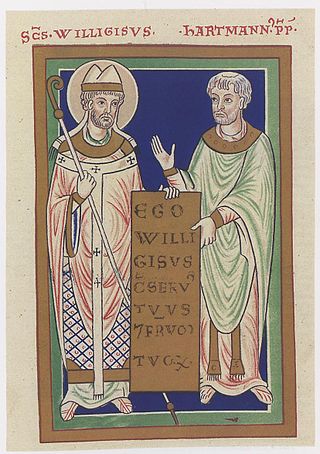
Willigis was Archbishop of Mainz from 975 until his death as well as archchancellor of the Holy Roman Empire.

Karl Theodor Anton Maria von Dalberg was a Catholic German bishop and statesman. In various capacities, he served as Prince-Archbishop of Regensburg, Arch-Chancellor of the Holy Roman Empire, Bishop of Constance and Worms, Prince-Primate of the Confederation of the Rhine and grand duke of Frankfurt. Dalberg was the last Archbishop-Elector of Mainz.

The House of Schönborn is the name of an ancient noble and mediatised formerly sovereign family of the former Holy Roman Empire.

Johann Philipp von Schönborn was the Archbishop-Elector of Mainz (1647–1673), the Bishop of Würzburg (1642–1673), and the Bishop of Worms (1663–1673).
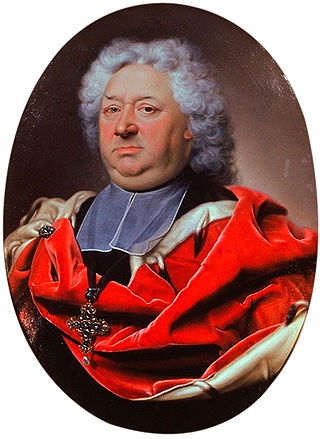
Lothar Franz von Schönborn-Buchheim was the Archbishop-Elector of Mainz from 1694 to 1729 and the Bishop of Bamberg from 1693 to 1729. As Archbishop of Mainz, he was also Archchancellor of the Holy Roman Empire. Lothar Franz von Schönborn is known for commissioning a number of Baroque buildings, such as the palace Schloss Weissenstein.

Baron Wilhelm Emmanuel von Ketteler was a German theologian and politician who served as Bishop of Mainz. His social teachings became influential during the papacy of Leo XIII and his encyclical Rerum novarum.
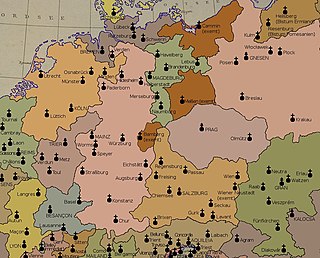
Primas Germaniae is a historical title of honor for the most important Catholic bishop in the German lands. Throughout the history of the Holy Roman Empire, it was claimed by the Archbishops of Mainz, Trier, Magdeburg and Salzburg alike. Actual prerogatives, however, were exercised by bishops holding the rank of an Apostolic legatus natus. While Mainz, Trier and Magdeburg lost the primatial dignity upon the 1648 Peace of Westphalia and the Napoleonic Secularisation in 1802, the Salzburg archbishops bear the title up to today.
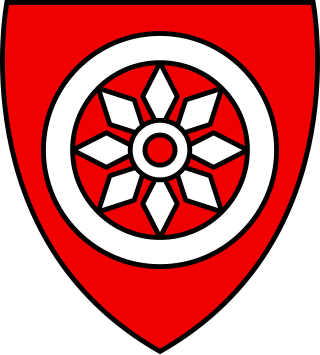
The Elector of Mainz was one of the seven Prince-electors of the Holy Roman Empire. As both the Archbishop of Mainz and the ruling prince of the Electorate of Mainz, the Elector of Mainz held a powerful position during the Middle Ages. The Archbishop-Elector was president of the electoral college, archchancellor of the empire, and the Primate of Germany as the papal legate north of the Alps, until the dissolution of the empire in 1806.
Conrad of Wittelsbach was the Archbishop of Mainz and Archchancellor of Germany from 20 June 1161 to 1165 and again from 1183 to his death. He was also a cardinal of the Roman Catholic Church.
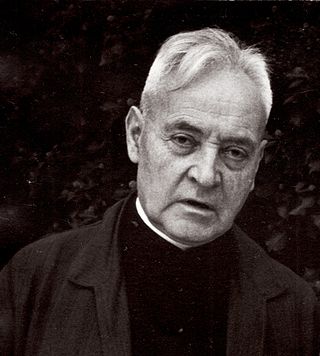
Hermann Volk was a German cardinal of the Roman Catholic Church. He served as Bishop of Mainz from 1962 to 1982, and was elevated to the cardinalate in 1973.

Adam Franz Lennig was an ultramontane German Catholic theologian. He was born and died in Mainz.

Henry V was King of Germany and Holy Roman Emperor, as the fourth and last ruler of the Salian dynasty. He was made co-ruler by his father, Henry IV, in 1098.
Adalbert of Saxony was administrator of the Archdiocese of Mainz as Adalbart III.
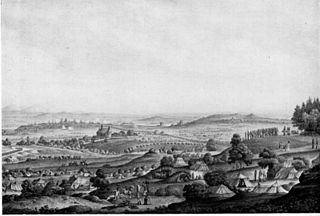
The siege of Mainz was a short engagement at the beginning of the War of the First Coalition. The victorious French army of Custine seized the town on October 21, 1792, after three days of siege. The French occupied Mainz, and tried to install the Republic of Mainz there.
References
- ↑ Dryer, George Herbert (1897). History of the Christian Church: The preparation for modern times 600-1517 A.D. Curts & Jennings. pp. 77–78.